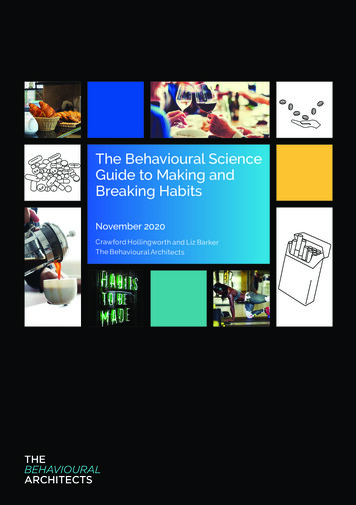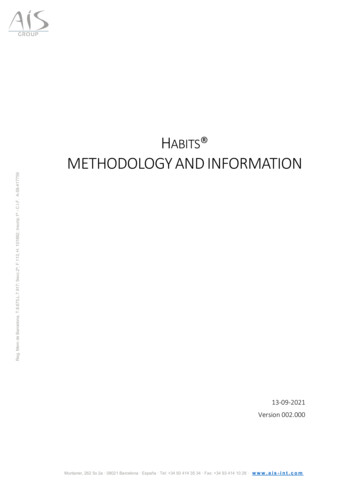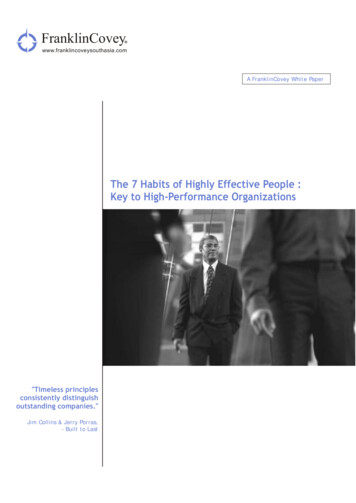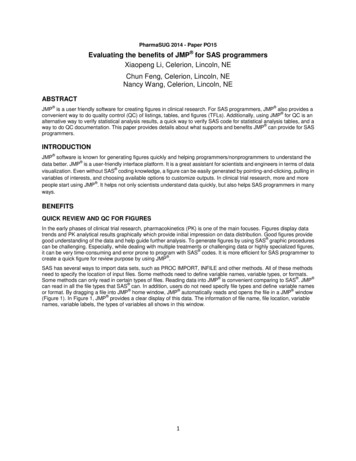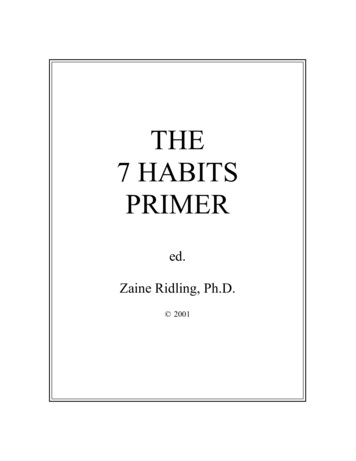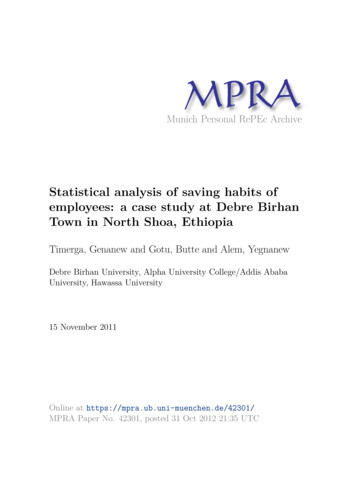
Transcription
Munich Personal RePEc ArchiveStatistical analysis of saving habits ofemployees: a case study at Debre BirhanTown in North Shoa, EthiopiaTimerga, Genanew and Gotu, Butte and Alem, YegnanewDebre Birhan University, Alpha University College/Addis AbabaUniversity, Hawassa University15 November 2011Online at https://mpra.ub.uni-muenchen.de/42301/MPRA Paper No. 42301, posted 31 Oct 2012 21:35 UTC
Statistical Analysis of Saving Habits of Employees: A Case Study at Debre BirhanTown in North Shoa, EthiopiaGenanew Timerga 1 (M.Sc), Butte Gotu (PhD) 2, Yegnanew Alem 3 (M.Sc)1Debre Birhan University, Po. Box 445, Tel: 251913054542, tichdar@gmail.com2Alpha University College/Addis Ababa University, Tel: 251911405942,buttegotu@gmail.com3Hawassa University, Po. Box 05, Tel: 251911380766 yegna2009@gmail.comABSTRACTSaving represents one of the most predictable determinants of successful personal andeconomic development. People desire to save although they tend to postpone saving untilthey have higher-paying jobs or some stability in their lives. However, in developingcountries, where opportunities for structured and institutionalized saving are rare, peoplecould perhaps begin saving earlier than expected. The purpose of this study has been toassess saving habits and identify factors that influence the saving habits of employees atDeber Birhan town. A sample of 480 was collected from employees on saving habit atDebre Birhan town during February, 2010 to October, 2011. Saving habit was measuredaccording to multi method tool that incorporates self report, visual analog scale andeconomic identification test. Descriptive, Binary logistic regression and Bayesianstatistical methods were used. The result indicates that 47.29% employees had no savingexperience and 52.71% of the respondents have been involved in saving part of theirincome. It was also found that government employees have lower saving habits than theprivate employees. The results obtained from the analysis of binary logistic regressionindicate that age, education, number of dependent family members, transport service, jobsatisfaction in the sector, cost of expenditures and inflation significantly affect the savinghabits of employees. Being a member of saving association, cost of recreation andhousing are also significantly related with saving habits of employees. Results frombinary logistic regression indicate that after controlling other variables in the model, theodds of saving decreases for instance by 43.4% for one unit increases in number ofdependent family members. Employees who had job satisfaction in the sector were lesslikely to be in no saving habit with odds 2.491. The result from Bayesian analysisindicates that monthly salary, distance from home to work place and supporting otherswith money were significant predictors of saving habits. Furthermore, education, numberof dependent family members, cost of expenditures and monthly salary are importantfactors affecting saving habits of employees.Key words: Bayesian Logistic Analysis, Binary Logistic Regression, Saving Habit,
CHAPTER ONE: INTRODUCTION1.1. Background of the StudyPersonal saving has two primary functions. First, savings provide the economic securityof a safety net. By transferring resources from the present to the future via savings,individuals are prepared to face unexpected and irregular financial circumstances.Second, saving leads to accumulation of wealth that enables individuals to improve theirliving standard and to respond to new opportunities (Gokhale, 2000). Everyone agreesthat starting to save early has merit in it and "Money grows on the tree of patience" andthere are benefits of “power of compounding”, but few actually practice it.When it comes to saving, people in general and the poor in particular might not becompletely rational and completely knowledgeable (Karim, 2010).The goal of promotingfinancial saving habit is to make people more aware of financial opportunities, choices,and possible consequences. There is a growing recognition of the importance of financialeducation as it relates to saving (Greenwald et al., 2001; Gill, 2004). Financial educationis one way of increasing savings and asset accumulation. Sherraden et al., (2007) say thatthe extent to which an individual understands the process and benefits of assetaccumulation is likely to affect their willingness to save.As few studies are available on saving in Ethiopia, this study intends to fill this gap with afocus on the ANRS. The regional capital of ANRS, Bahir dar, is the only really big urbancenter in the region, and since the last dozen years, it has grown substantially in size andeconomic activity. Assessing employees’ saving habits has been crucial, which is as goodas null at present, and hence Debre Birhan Town has been selected for the present study. Itis, therefore, important to conduct researches on employees’ saving habits.Furthermore, the statistical models which the researcher mainly concentrated in this studyare the logistic regression model and Bayesian logistic regression model to identifysignificant factors associated to no-saving related to employees.1.2 Statement of the ProblemMost of the developing countries have low rate of saving habits, so that improving savinghabit is a primary goal for people living in this part of the world (Michael et al., 2001).Improving saving habit of individuals is given attention to look at a variety of savings1
services used by people/customer in the community. Improving this depends not only onattending of government provider but also on appropriate execution of recommendedcomponents of saving in household of the community and institutions or sectors.However, most of the studies focus on descriptive statistics produce hard-to-generalize ona wider perspective. So that the following important issues is identified.o Saving habit and institutions of saving area have become increasingly importantfor safety nets of the employees.o Investigation of factors associated with saving habits assumes critical importance.o Provision of saving services varies widely across individuals in Ethiopia.o Understanding these variations at the individual and in the community level inorder to successfully implement any saving related policies and programs.Thus, the purpose of this study is to assess the current status of saving habits services, andfactors that influence utilization of these services, and to find out the possible reasons forunderutilization of saving habit services using primary data collected from Debre Birhan,one of the cities in ANRS, Ethiopia.1.3 Objectives of the Study1.3.1 General Objective:To assess saving habits and identify factors that influence the saving habits of employeesat Deber Birhan town.1.3.2 Specific Objectives: To assess the current status of saving practices of the employees at Deber Birhantown; To identify factors that influence the saving habits of employees; To evaluate the capacity of saving institutions that employees they used; To provide or document information for decision makers, planners andresearchers.2
1.4 Significance of the StudyAssessing saving habits is very important to understand and evaluate the achievementgained in the implementation of saving programmers as a source of information for theemployees about the benefit of saving in improving employee life. It is hoped that resultsof this study will improve policy makers’, planners’ and researchers’ understanding of thedeterminants of saving habits of employees in the study area and may serve as animportant tool for any possible information towards improving saving habits.This research is essential as it contributes to the efforts of the country in improving savinghabits of employees.CHAPTER TWO: LITERATURE REVIEW2.1 Literature Review in EthiopiaThe study of saving has a contribution to change personal behavior and economicalgrowth in the country. Dedebit Credit and Saving Institution (DECSI) and Amhara Creditand Saving Institutions (ACSI) take more than 65% share in serving clients in the market(Befekadu, 2007). Higher Gross Domestic Savings (GDS) has improved the savingincome function of employees. The major determinants of GDS are demographic aspect,interest rate, tax, broad money, stage and duration of disease, association of infectiousdisease, export, etc. The result of his study shows export has high value to saving habit;tax has a significant positive effect when it regresses on private saving.The impact assessment of micro finance records positive results of saving habits in thecountry by different researchers. Mengistu (1997) shows that increase in the number ofprogram beneficiaries is one indicator of the contribution of assistance program toemployment creation and income generation.Kassa (1998) shows in South Ethiopia in the area of education, consumption expenditure,medical expenditure, family assistance, employment creation, income generation are veryimportant to saving habits. In addition, Kassa (1998) reported a 30.82%, 10.5% and19.7% annual growth in consumption expenditure of the first, second and third creditcycle beneficiaries, respectively. About 7%, 8.03% and 2.07% growth in first, second and3
third saving cycle beneficiaries’ case, respectively. Using Wilcoxon grouped pair'snonparametric test, he did not accept the null hypothesis of average income before andafter saving are the same at 5% level of significance implying that the average incomeafter saving is greater than before saving in the first, second and third credit cycle.2.2 Saving InstitutesAt this time, there are different types of saving system in the world. This is categorized into three ways, and these are formal saving sector (saving and credit co-operatives(SACCOS), bank and insurance companies), semi-formal saving sector (microfinanceinstitutions (MFI)) and informal saving sector (save at home, save at clubs, depositcollector, reciprocal lending, rotating savings and credit association (ROSCA),accumulation savings and credit association (ASCAS) etc) (Ziorklui and Barbee, 2003).Informal savings have different names in different countries.In Ethiopia, the effective financial structure has 95% of the productive asset which iscomposed of 70-80% loan and 10-20% liquid investment and the remaining 5% isunproductive assets composed of land, buildings and equipments. On the other hand, 7080% of credit union liability should be composed of members’ savings to achievefinancial independence. In order to finance non-performing assets, improve earnings andabsorb losses, members share capital and institutional capital should be greater or equal to20% and to 10% of total asset respectively. Rate of return and costs operating expense tototal assets ratio is set to be less than 10% and other return and costs to be greater or equalto market rate. However, administrative cost should not be greater than 5% of the averagetotal assets (Gebeyaw, 2008).In our country, there are different traditional financial systems which have long historyand paramount contribution to economic betterment and social wellbeing of the society.Traditional institutions organized with a sense of cooperation and risk sharing has enabledEthiopians to experience saving and financial management within its cultural context."Eqqub", "Eddir", "Mahiber" etc are some of the informal financial institutions thatshaped the social bond and interaction (Gebeyaw, 2008).Characteristics of Saving AssociationsThe most important purpose of saving institutions is to make mortgage loan on residentialproperty. These organizations are known as saving associations, building loanassociations and cooperative banks. As home-financing institutions, they give primary4
attention to single-family residences and are equipped to make saving in this area. Someof the most important characteristics of a savings association are:1. It is generally a locally owned and privately managed home financing institution.2. It receives individuals’ savings and uses these funds to make long-term amortizedloans to home purchasers.3. It makes save for the construction, purchase, repair, or refinancing of houses.4. It is state or federally chartered.Ugandan, survey 87% of respondents said that a service delivery point in their sub-districtwould satisfy their needs as savings clients (Pelrine et al., 2005). As a result, informal andsemi-formal savings mechanisms can out-compete formal sources on proximity, helpingexplain why relatively risky informal mechanisms are still the most widely used by lowincome Ugandans. And also distance of financial sector affects saving rate of households.Return on Equity (ROE) of NBE WSACA was 37%, 32% and 30% in 2005, 2006 and2007 respectively, which was closer to ROE of commercial banks (32.7%, 40.7%and 29%in the respective years). ROE of MFI industry, on the other hand was 55%, 45% and 50%during the respective years, which was significantly higher than the later year (NBEWSACA, 2008). Similarly, in rural Ethiopia, most of the people use informal savingmechanisms because they are far away from the financial institutes or sectors.5
CHAPTER THREE: METHODOLOGY3.1 Description of the Study AreaThis study was conducted at Debre Birhan town, the capital of North Shoa or "SemenShewa" zone from February to October, 2011. According to CSA (2008) report, theestimated population size of Debre Birhan town was 65,244 out of these 31,658 weremale and 33,556 were female.3.2 Study PopulationThe target population consists of all employees at Debre Birhan town. A total of 5113employees within the age interval of 18 to 75 years were considered.3.3 Sampling Design and TechniquesThe data which is cross-sectional were collected from the target population through astructured questionnaire.3.3.1. SamplingStratified random sampling is used where the researcher draws simple random samplesfrom certain aggregation units of interest (from certain census block groups) when thestrata are heterogonous geographic units and also from successively smaller aggregationsuntil the individual subject level is reached.In this study using stratified random sampling method, government and privateemployees were selected with probability proportional to size without replacement(ppswor) as primary sample units (strata), individual employee (secondary unit samples)from each selected stratum with systematic sampling. Strata 1 : All employee that arework in the government organization. Strata 2: All employee that are work in the privateorganization. The sampling frame was prepared from government and private employeesby giving sequential order number. Finally an employee selected by systematic randomsampling procedure was contacted.3.3.2. Sample Size DeterminationThe sample size for this study was determined based on stratified sampling forproportions of 95 percent confidence level. Moreover, 3 percent of the sample size isadded to compensate for non-response rate. The sample size formula is given by(Cochran, 1977)6
. 3.1where, is the specified variance of the estimate and in case of estimatingproportion, the stratum variance is given byforcommon p. Since we use proportional allocation sample,stands for stratum weight, N N1 N2wherebe the upperpoint of standard normal distribution, wheresignificance level, which is. Suppose the relative error0.05is usuallyset by the investigator desired which is used from a similar study undertaken by the"Saving habits, needs and priorities in urban Uganda" in 2005, with a sample size of 852is taken as a reference for the purpose of fixing the standard deviation. One of theexplanatory variables used in that study is customer saving with a standard deviation of0.45. This helps us to determine the sample size to represent the population by calculatingthe acceptable absolute error, d, where. If we adopt a significance level 0.05, then the calculated margin of error from the above information is 0.03. Previousstudies indicate that the proportion of saving habits of employees varies from study tostudy. In our study, it is indicated that the proportion of saving habits of employeeswasdetermined small proportion from the results of previous work of similar population ofsaving habits of employees in Chinese and Americans 14.02% (p 0.1402) of (Feifei,2010). Thus, the sample size calculation isFinally, 3 percent of the sample size, which is 15, was added to the determined sample7
size 475 to compensate for none response rate. Thus, the required sample size for thisstudy is 490 employees from 5113 who live at Debre Birhan town. Next, we carried outsample size allocation to each stratum with proportional allocation.Where,h types of employee 2Probability of stratum weight selection of hth employee,Totalnumber of employees within the hth strata, N Total number of employee in DB townTable 3.1 Number of Employee Taken from the Selected PSU at Debre BirhanSampleEmployeeGovernment (N1)35030.685336Private (N2)16100.315154Total51134903.4 The Study Variables3.4.1. Dependent VariableThe response variable in this study is the status of saving habits at Debre Birhan town.The habits of employees are identified either save out of income or no save out ofincome. The response variable is a dichotomous category and my interest of the study isno saving out of income. Thus, coded as the value 0 for 'save out of income' and 1 for 'nosave out of income'.3.4.2. Independent VariablesThe independent variables in this study are classified as occupational variables, economicvariables and personal relationship and contextual variables.3.5 Logistic Regression ModelLogistic regression analysis extends the techniques of multiple regression analysis toresearch situations in which the outcome variable is categorical.8
Generally, the response variable is binary, such as (save or no save, presence or absence,success or failure etc) in logistic regression.3.5.1. Assumptions of Logistic RegressionAssumptions were should consider for the efficient use of logistic regression as givenbelow (Hosmer and Lemeshow, 1989). Logistic regression assumes meaningful coding of the variables. Logisticcoefficients were difficult to interpret if not coded meaningfully. The conventionfor binomial logistic regression is to code the dependent class of interest as 1 andthe other class as 0. Logistic regression does not assume a linear relationship between the dependentand independent variables. The dependent variable must be categorical. The independent variables need not be interval, no normally distributed, nolinearly related and no equal variance within each group. The groups must be mutually exclusive and exhaustive; a case can only be in onegroup and every case must be a member of one of the groups. Larger samples are needed than for linear regression because maximum likelihoodcoefficients are large sample estimates. The logit regression equation should have a linear relationship with the logit formof the dependent variable. Absence of multicollinearity.3.5.2. Model DescriptionSince the response variable in logistic regression is usually dichotomous, we were definesuch a response variable as Y, and denote the even y 1, when the subject has thecharacteristic of interest and y 0, when the subject does not have that characteristic ofinterest. So an alternative form of the logistic regression equation is the logittransformation of Pi given as9
The coefficient can be interpreted as the change in the log-odds associated with a one unitchange in the corresponding independent variable or the odd increases multiplicatively byfor every one unit change increase in.3.5.3. Parameter Estimation for Logistic RegressionThe maximum likelihood and non-iterative weighted least squares are the two mostcomputing estimation methods used in fitting logistic regression model (Hosmer andLemeshow, 1989).Consider the logistic model, since observed values of Y say, Yi’s (i 1, 2 , n) are independently distributed as binomial and, the maximum likelihood function ofY is given by:3.6.1. Model SelectionIn model selection, there are two competing goals: on one hand the model should becomplex enough to fit the data well. On the other hand, it should be simple to interpret,smoothing rather than over fitting the data (Agresti, 2002).3.6.2. Goodness of Fit of the ModelAssessing goodness of fit involves investigating how close values predicted by the modelwith that of observed values (Bewick and Jonathan, 2005). The comparison of observedto predicted values using the likelihood function is based on the statistic called deviance.For purposes of assessing the significance of an independent variable, the value of D arecompared with and without the independent variable in the equation as given below: D (model without the variable)The goodness-of-fitD (model with the variable)process evaluates predictors that are eliminated from the fullmodel, or predictors (and their interactions) that are added to a smaller model.10
3.6.3. Likelihood-Ratio TestThe likelihood ratio test statistic (G2) is the test statistic commonly used for assessing theoverall fit of the logistic regression model. The likelihood-ratio test uses the ratio of themaximized value of the likelihood function for the full model (L1) over the maximizedvalue of the likelihood function for the simpler model (L0). The likelihood-ratio teststatistic is given:It is compared with adistribution with 1 degree of freedom. This log transformation ofthe likelihood functions yields a chi-squared statistic.3.6.4. The Hosmer and Lemeshow Test StatisticThe final measure of model fit is the Hosmer and Lemeshow goodness-of-fit statistic,which measures the correspondence between the actual and predicted values of thedependent variable.Where g is the number of groups,is the number of covariate patterns in the kth group,is the number of responses among thecovariate patterns, andis the average estimated probability.3.6.5. The Wald StatisticThe Wald statistic is an alternative test, which is commonly used to test the significanceof individual logistic regression coefficients for each independent variable (that is to testthe null hypothesis in logistic regression model that a particular logit coefficient is zero).If the Wald test is not significant, then these explanatory variables can be omitted fromthe model. Wald 2 statistic was used to test the significance of individual coefficients inthe model and is calculated as:Each Wald statistic is compared with adistribution with 1 degree of freedom. Waldstatistic is easy to calculate but their reliability is questionable, particularly for smallsamples.11
3.6.6. R2 StatisticA number of measures have been proposed in logistic regression as an analog to R 2 inmultiple linear regressions. The Cox and Snell measure is based log-likelihoods andconsiders sample size. The maximum value that the Cox and Snell R2 attain is less than 1.The Nagelkerke R2 is an adjusted version of the Cox and Snell R2 and covers the fullrange from 0 to 1, it is often preferred.Therefore, in this study R2 statistic to indicate how useful the explanatory variables are inpredicting the response variables were used (Bewick and Jonathan, 2005).The Nagelkerke measure is as follows:Where3.7 Bayesian Analysis3.7.1. Bayesian Logistic RegressionThe foundation of Bayesian statistics is the Bayes' theorem which states that if A and B,are events and, the probability of event B, is greater than zero, then:3.7.2. The Likelihood and Prior FunctionLikelihood FunctionThe likelihood functionof the Bayesian formulation for the joint distribution of nindependent Bernoulli trials was still the product of each Bernoulli distribution, the sumof independent and identically distributed Bernoulli trials in which the sum has aBinomial distribution. Specifically, let y1, y2 yn be independent Bernoulli trials withsuccess probabilities P1, P2, P3, , Pn, that is yi 1 with probability Pi or yi 0 withprobability 1- Pi, for i 1,2, ,n. The trials are independent, the joint distribution of y1, y2,. . . yn is the product of n Bernoulli probabilities. As usual, the likelihood, function usedby Bayesians matches that from frequents inference. binomial:12
n[L( y β ) Pi i (1 Pi ) (1 yi )y]i 1Where, pi represents the probability of the event for subject i who has covariate vector Xi,yi indicates the presence, yi 1, or absence yi 0 of the event for that subject.βPi e 01 e β1β βoxi11 .xi1 β .kx βi kkxi kwhere: Pi the probability of ith employees being save, since individual subjects areassumed independent from each other likelihoods function over a data set of subjects is:nL( y β) i 1βo β1xi1 .βk xikeβ β x .β x1 e o 1 i1 k ikyiβo β1 xi1 . βk xik1 (1 yi )eβ β x .β x1 e o 1 i1 k ikPrior FunctionThe choice of an informative prior distribution typically involves a certain amount ofsubjectivity; historically, this has been a reason for disagreement between Bayesian andclassical statisticians. The assumed prior normal distribution for parameteris given by3.7.3. The Posterior DistributionBased on the prior distribution given above, the posterior distribution of the Bayesianlogistic regression contains all the available knowledge about the parameters in the modellike13
is the posterior distribution which is the product of the logistic regressionWherelikelihood and the normal prior distributions for theparameters.Note that the posterior distribution is a conditional distribution, conditional observing thesample. The posterior distribution is now used to make statements about, which is stilla random quantity. The most popular method of simulation technique is Markov ChainMonte Carlo (MCMC) methods.3.7.4. Markov Chain Monte Carlo (MCMC) MethodsThe use of Markov chain Monte Carlo (MCMC) methods to evaluate integral quantitieshas exploded over the last fifteen years. The primary distinction made here is betweenstandard Monte Carlo simulation and the Markov chain type of Monte Carlo methods.The initial definition required is that of a more primitive concept that underlies for thesecond MC which is called Markov chains.3.7.5. The Gibbs Sampler AlgorithmThe Gibbs sampler (David, 2006) is the most widely used MCMC technique. It is atransition kernel created by a series of full conditional distributions that is a Markovianupdating scheme based on conditional probability statements. If the limiting distributionof interest iswhereis an k length vector of coefficients to be estimated, then theobjective is to produce a Markov chain that cycles through these conditional statementsmoving toward and then around this distribution. The set of full conditional distributionsforare denotednotationand defined by( ) indicates a specific parametric form fromfor i 1, 2 k, where thewithout thecoefficient. Theserequirement facilities the iterative nature of the Gibbs sampling algorithm described as:1. Start with an initial value:2. Sample for each i 0, 1, 2. , n-1:14
Generate β 0(i 1)(f (βfrom f β 0 β 1Generate β1 (i 1) from1(Generate β 2 (i 1) from f βGenerate β k( i 1)2 β0 β(i),β2(i 1), β1(i 1)0(i),β3(i),β1(i),β2(i 1),., β k(i),β,., β k(i)2)(i)(i ),., β()(i)k))from f β k β 0 ( i 1 ) , β 1 ( i 1 ) , β 2 ( i 1 ) ,., β k 1 ( i 1 ) . .( 3 . 16 )3. Return β (1),. ., β (n )Once convergence is reached, all simulation values are from the target posteriordistribution and a sufficient number should then be drawn so that all areas of the posteriorare explored.3.7.6. Assessment of ConvergenceThere are basically three approaches to determining convergence for Markov chains:assessing the theoretical and mathematical properties of particular Markov chain,diagnosing summary statistics from in-progress models, and avoiding the issue altogetherwith perfect sampling, which uses the idea of “coupling from the past” to produce asample from the exact stationary distribution (Congdon, 2005). The second convergenceassessment methodology involves monitoring the performance of the chain as part of theestimation process and making an often subjective determination about when to stop thechain. Among several ways the most popular and straight forward convergenceassessment methods are:1. Autocorrelation: High correlation between the parameters of a chain tends to giveslow convergence, whereas high autocorrelation within a single parameter chain leadsto slow mixing and possibly individual non convergence to the limiting distributionbecause the chain will tend to explore less space in finite time. In analyzing Markovchain autocorrelation, it is helpful to identify lags in the series in order to calculate thelonger-run trends in correlation, and in particular whether they decrease withincreasing lags. These can be accessed in WinBUGS using the “autcor” button on theSample Monitor Tool.2. Time series plots: Iteration numbers on x-axis and parameter value on y-axis arecommonly used to assess convergence. If the plot looks like a horizontal band, with nolong upward or downward trends, then we have evidence that the chain has converged.These can be accessed in WinBUGS by using the “history” button.15
3. Gelman-Rubin statistic: for a given parameter, this statistic assesses the variabilitywithin parallel chains as compared to variability between parallel chains. The model isjudged to have converged if the ratio of between to within variability is close to 1.Plots of this statistic can be obtained in WinBUGS by using the “bgr diag” button. Thegreen line represents between variability, the blue line represents within variability, andthe red line represents the ratio. Evidence for convergence comes from the red linebeing close to 1 on the y-axis and from the blue and green lines being stable(horizontal) across the width of the plot.4. Density plot: a classic sign of non convergence is multimodality of the density estimate.3.7.7. The Burn-in Peri
Debre Birhan University, Alpha University College/Addis Ababa University, Hawassa University 15 November 2011 Online at https://mpra.ub.uni-muenchen.de/42301/ . 2Alpha University College/Addis Ababa University, Tel: 251911405942, buttegotu@gmail.com 3Hawassa University, Po. Box 05, Tel: 251911380766 yegna2009@gmail.com
